Red light wavelengths (630-1000nm) boost your cellular energy by targeting your mitochondria, the powerhouses inside your cells. When these rays hit a key enzyme called cytochrome C oxidase, they break down nitric oxide bonds and decrease water viscosity in the mitochondria. This enhances electron transport and oxygen utilization, leading to increased ATP production – your cells' primary energy source. Pulsed light works even better than continuous exposure, with specific wavelengths like 850nm and 940nm proving most effective. The deeper science behind this natural energy-boosting process reveals even more fascinating cellular benefits.
The ATP Energy Cycle
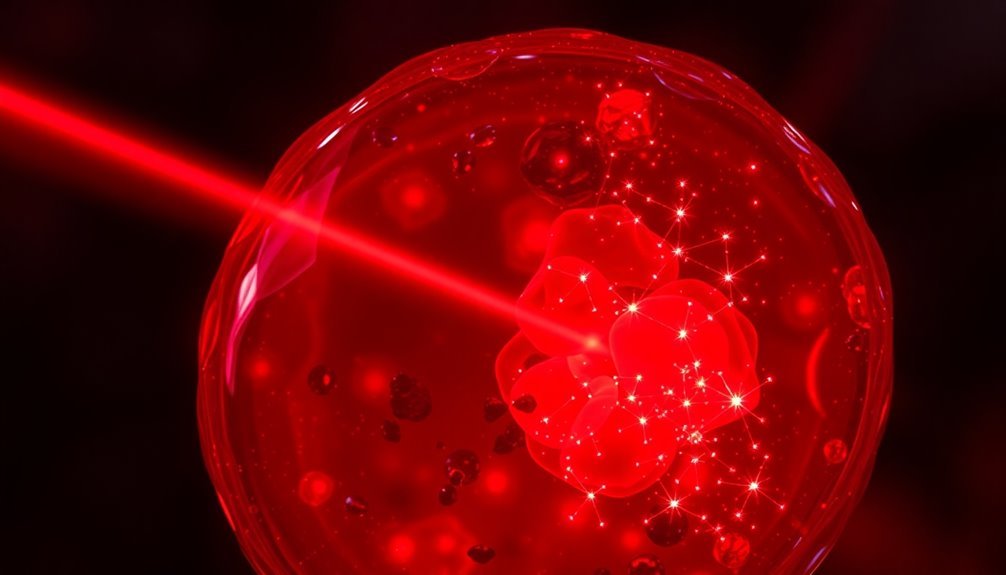
Deep within every cell, mitochondria drive the intricate ATP energy cycle that powers life itself. These cellular powerhouses are constantly working to generate ATP through a complex process called oxidative phosphorylation.
You'll find the electron transport chain at the heart of this process, where electrons flow systematically while building up potential energy from hydrogen ions. Red light therapy enhances this process by disrupting nitric oxide binding and optimizing electron transport.
When you look closer at cellular respiration, you'll see it unfolds in distinct stages. It starts with glycolysis, moves through pyruvate oxidation, enters the citric acid cycle, and culminates in oxidative phosphorylation.
At each step, your cells are working to extract and convert energy from nutrients into usable ATP.
Your mitochondria are remarkably adaptive, with their numbers varying based on your cells' energy demands. They're unique organelles, containing their own DNA and ribosomes, and they're responsible for more than just energy production – they also play significant roles in cell signaling and steroid synthesis.
The efficiency of your ATP production directly impacts your overall health and energy levels, which is why maintaining ideal mitochondrial function is essential for your body's performance and well-being.
Understanding Cellular Power Plants
Your mitochondria act as microscopic power plants, working tirelessly to convert the food you eat into usable cellular energy called ATP.
These remarkable organelles pump out massive quantities of ATP through a complex process called oxidative phosphorylation, which occurs along their folded inner membranes.
You'll find more mitochondria in cells that need lots of energy, like your muscle cells and brain neurons, where they're constantly running their ATP production lines to keep you moving and thinking. The typical human body recycles an amount of ATP equal to its weight each day, highlighting just how crucial these cellular powerhouses are.
Mitochondria's Energy Production Role
Mitochondria consistently serve as cellular power plants, producing most of your body's energy through a complex process called oxidative phosphorylation. Inside each mitochondrion, the inner membrane folds into cristae, creating an expansive surface area where essential energy-producing reactions occur.
The process begins in the matrix, where the citric acid cycle breaks down nutrients to produce NADH and FADH2. These molecules then transfer their electrons to the electron transport chain located on the cristae. The electron transport chain consists of four main complexes that efficiently transfer electrons between them. As electrons move through protein complexes, protons are pumped across the inner membrane, creating a gradient. You can think of this gradient as stored energy, similar to water behind a dam.
ATP synthase, acting like a molecular turbine, harnesses this proton gradient to convert ADP into ATP – your cells' primary energy currency. Oxygen plays a significant role as the final electron acceptor, combining with hydrogen to form water.
Your most energy-demanding cells, like those in your heart, contain more mitochondria to meet their high energy needs. When mitochondria don't function properly, it can lead to various diseases and disorders, highlighting their critical role in maintaining your health.
ATP Synthesis In Action
Inside the intricate cellular machinery, ATP synthesis operates like a precisely choreographed molecular dance. You'll find a complex series of stages working together to transform your food into usable cellular energy.
| Stage | Function |
|---|---|
| Glycolysis | Breaks down glucose into pyruvate molecules |
| Pyruvate Oxidation | Converts pyruvate to Acetyl-CoA, creating NADH |
| Citric Acid Cycle | Harvests electrons to form NADH and FADH2 |
| ETC | Moves electrons through complexes to pump H+ ions |
| ATP Synthase | Produces ATP as H+ ions flow through it |
The human body demonstrates remarkable efficiency by recycling ATP daily in quantities equivalent to its own body weight. When you expose your cells to red light therapy, you're enhancing this entire process. The light wavelengths (630-850 nm) target your mitochondria directly, breaking the bonds between nitric oxide and cytochrome c oxidase. This frees up the electron transport chain to work more efficiently. Without NO blocking the way, oxygen can better participate in ATP production, and electrons flow more smoothly through the protein complexes. The result is increased ATP production and reduced oxidative stress, giving your cells more energy to power their essential functions.
Red Light Wavelength Science
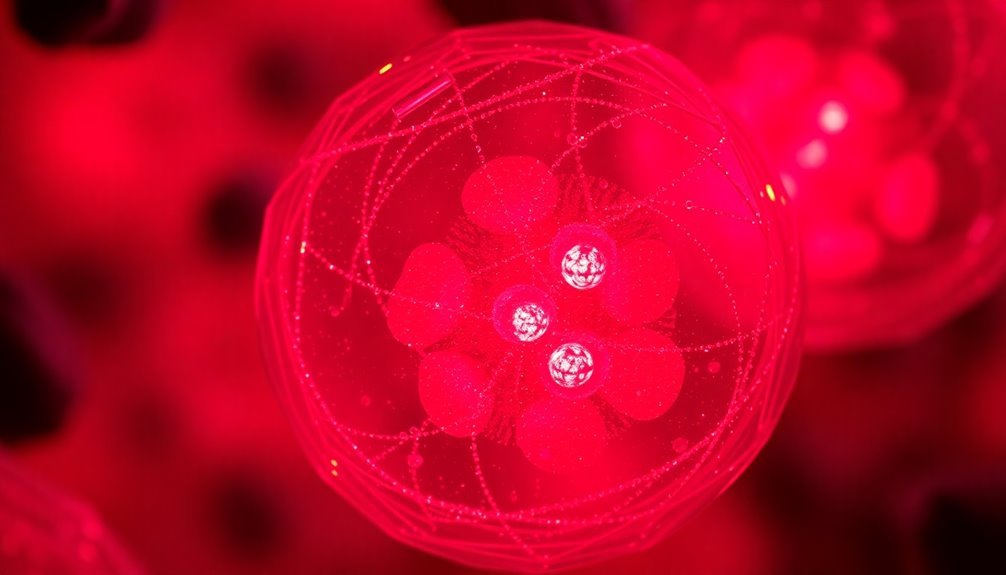
Red light therapy works best within specific wavelength ranges of 630-1000 nanometers, which scientists call the "therapeutic window" for boosting cellular energy production.
You'll find that shorter wavelengths around 610-760 nm primarily benefit your skin cells, while near-infrared wavelengths between 760-1400 nm can reach deeper tissues, penetrating up to 50 millimeters below your skin's surface.
These distinct wavelength ranges interact differently with your cells' mitochondria, making it essential to match the right wavelength to your specific treatment needs. The optimal power range of 0.8-1.1 W is crucial for enhancing ATP production within cells.
Optimal Wavelength Ranges
Understanding the ideal wavelengths for light therapy reveals two key ranges: 630-670nm for red light and 810-890nm for near-infrared light. Within these ranges, you'll find that 670nm and 830nm are particularly effective because they directly interact with cytochrome c oxidase, a vital enzyme in your cells' mitochondria.
When you're looking at specific wavelengths, you should know that 632.8nm to 853nm effectively enhance ATP production by stimulating your mitochondrial complexes. The near-infrared range of 810-890nm penetrates deeper into your tissues, making it especially useful for targeting cells beneath your skin's surface. Pure red wavelengths are essential since other colors like blue or green can inhibit therapeutic effects.
You'll get different benefits depending on which wavelength you choose. For instance, 632.8nm specifically targets complex IV in your mitochondria, while 980nm works with complex III. Research shows that 670nm and 830nm outperform other wavelengths like 728nm in effectiveness.
The power intensity matters too – you'll need between 0.5W and 1.1W for best results. Lower powers around 0.1W might actually create oxidative stress, so it's important to use the right intensity for your treatment.
Light Penetration Depth Analysis
When analyzing how deeply light penetrates human tissue, you'll find that wavelength plays an essential role in determining effectiveness. Red light at 650nm penetrates about 1.57mm into muscle tissue, while near-infrared light at 830nm reaches deeper at 3.23mm. You'll notice that longer wavelengths generally penetrate more effectively. For optimal treatment results, skin contact placement significantly enhances light penetration by reducing reflection losses.
| Wavelength | Penetration Depth | Tissue Type |
|---|---|---|
| 600-700nm | Up to 1mm | General |
| 780-980nm | Up to 2mm | General |
| 632.8nm | 1.69mm | Breast |
| 780nm | 2.06mm | Breast |
| 830nm | 3.23mm | Muscle |
The intensity of the light also matters considerably for penetration depth. You'll need higher intensities to reach deeper tissues, but there's a careful balance to maintain. For instance, you might need up to 5,000 mW/cm² to effectively reach 5cm deep, while targeting brain tissue at 3cm depth could require up to 15 Watts. However, you must avoid excessive intensity that could cause tissue damage. Different tissues absorb light differently, so the same wavelength won't penetrate equally through skin, fat, and muscle.
Mitochondrial Response to Light
Inside cells, mitochondria respond dynamically to specific wavelengths of light between 630nm and 1000nm, particularly in the red to near-infrared (NIR) spectrum.
When these light waves reach your cells, they trigger a fascinating chain of events within the mitochondria, your cellular powerhouses.
You'll find that light exposure enhances ATP production through several mechanisms. The light decreases the viscosity of water inside mitochondria, which lets the ATP synthase rotate faster.
It's worth noting that pulsed light works even better than continuous light for boosting ATP synthesis, likely due to its combined effects on metabolism and viscosity reduction.
Specific wavelengths like 850nm and 940nm directly stimulate your electron transport system and cytochrome c oxidase activity.
When you're exposed to these wavelengths, your cells become more resistant to external stress, and their respiration improves.
Your neuronal mitochondria are particularly responsive to this light therapy, helping them meet increased ATP demands.
The process involves both activating specific cellular pathways and reducing harmful reactive oxygen species.
Scientists can now track these ATP changes in real-time using advanced techniques like the MitoRAISE assay.
The moderate light intensities used in this therapy, maxing at a few kW/m², ensure the treatment remains non-destructive while still being effective.
Cytochrome C Oxidase Activation
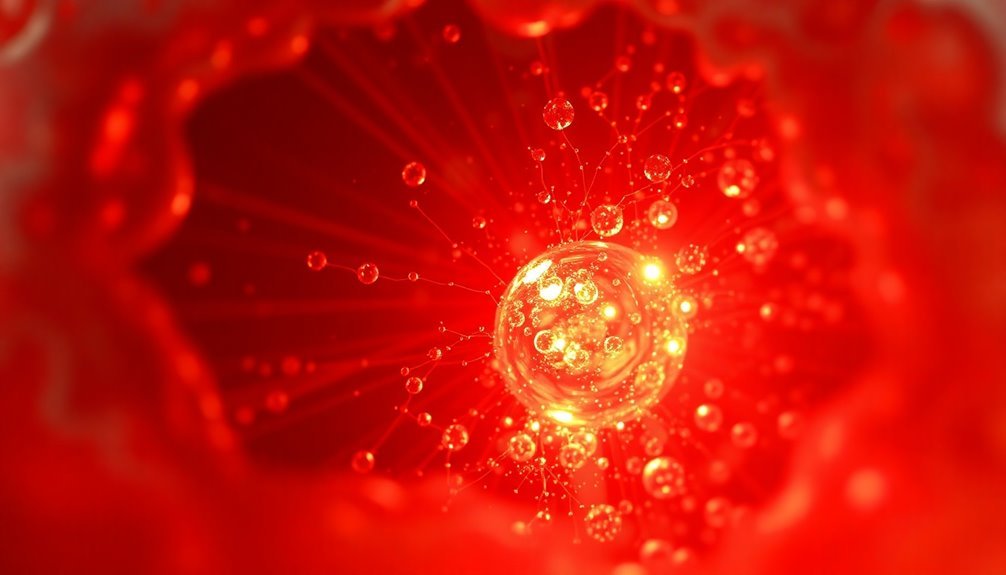
When red light strikes cytochrome c oxidase in your cells, the enzyme's chromophores readily bind with and absorb these specific wavelengths.
This binding triggers enhanced electron flow through the enzyme's copper atoms and cytochromes, boosting its natural activity in the electron transport chain.
Your cells can then use oxygen more efficiently, as the activated cytochrome c oxidase speeds up the conversion of oxygen to water while pumping more protons for ATP production. This critical enzyme is responsible for 95% of ATP synthesis in your body's cells.
Enzyme Binding With Light
Through a remarkable process, red and near-infrared light wavelengths (600-810 nm) directly activate cytochrome c oxidase (CCO), a vital enzyme in cellular energy production. When light hits CCO, it's absorbed by specific chromophores within the enzyme, triggering changes in its redox state.
You'll find that this binding process peaks at distinct wavelengths: 430, 530, and 570 nm, matching the absorption spectrum of reduced cytochrome b.
The light-enzyme interaction doesn't stop there. When the light binds to CCO, it activates NADH cytochrome c reductase and succinate cytochrome c reductase in your mitochondria. This activation is significant because it enhances the electron transport chain's efficiency, leading to increased oxygen reduction and ATP production. In cases where carbon monoxide inhibition occurs, light exposure can help restore normal enzyme function.
You're fundamentally witnessing a molecular switch being turned on by light.
What's particularly interesting is how this binding mechanism affects cellular function. As the light activates CCO, it triggers the production of reactive oxygen species (ROS), which, contrary to what you might expect, can actually promote beneficial effects like neurite growth.
This process is so precise that scientists can now design specific lighting systems to optimize this enzyme-light interaction for therapeutic purposes.
Electron Flow Enhancement
Red light's activation of cytochrome c oxidase sets off a precise electron flow pathway that amplifies cellular energy production. When activated, electrons move efficiently from cytochrome c to CuA, then to heme a, and finally to heme a3 before reaching oxygen. This enhanced electron transfer process accelerates at rates up to 20,000 transfers per second through the CuA to heme a pathway.
You'll find this acceleration particularly important at the bionuclear center, where heme a3 and CuB work together to bind and reduce oxygen. As electrons flow more efficiently, the system pumps more protons across the membrane, creating a stronger electrochemical gradient. For every oxygen molecule that's reduced, you get four protons pumped across the membrane.
The enhanced electron flow directly impacts ATP production by strengthening the proton motive force that drives ATP synthase. With a redox potential of +0.82 V, you're looking at an energy conversion efficiency of 70-80%. This means more ATP production for your cells, as the system optimizes the transfer of both electrons and protons through the protein's carefully structured pathways.
Oxygen Utilization Increases
Mitochondria's powerhouse enzyme, cytochrome c oxidase (CCO), dramatically increases its oxygen utilization when exposed to red light therapy. As the rate-limiting enzyme in cellular respiration, CCO transforms oxygen into water while generating energy for ATP production. When red to near-infrared light hits CCO, it enhances the enzyme's ability to process oxygen more efficiently.
You'll find CCO embedded in your mitochondrial inner membrane, where it orchestrates the final step of the electron transport chain. It's here that CCO helps create a proton gradient essential for ATP synthesis, converting one ATP molecule for every two electrons transferred from cytochrome c to oxygen.
| Process | Before Light Therapy | After Light Therapy |
|---|---|---|
| O2 Consumption | Normal Rate | Increased Rate |
| ATP Production | Baseline | Enhanced |
| Electron Flow | Standard | Accelerated |
| Energy Output | Regular | Optimized |
Your cells' energy production gets a boost because CCO responds to red light by shifting its redox state. This activation leads to improved tissue oxygenation and metabolic function, particularly beneficial in oxygen-demanding organs like your brain. The process works through CCO's specialized active site, cytochrome a3, which becomes more efficient at binding and reducing oxygen molecules.
Electron Transport Chain Enhancement
Because cellular energy production relies heavily on efficient electron transport, understanding how red light therapy enhances this process is vital.
When red and near-infrared light reach your cells, they target an essential enzyme called cytochrome C oxidase, which plays a key role in your electron transport chain. This enzyme often becomes inhibited when nitric oxide binds to it, reducing your cells' ability to produce ATP efficiently.
Red light therapy breaks the bond between nitric oxide and cytochrome C oxidase, restoring proper electron flow through the transport chain. Once freed from nitric oxide's inhibitory effects, your mitochondria can pump protons more effectively across their membranes, creating the gradient needed for ATP synthase to produce energy.
This enhanced electron transport leads to increased oxygen consumption and improved mitochondrial efficiency.
You'll benefit from this enhancement through increased cellular energy availability and reduced oxidative stress. Your cells can produce more ATP while generating fewer harmful reactive oxygen species, supporting various functions from muscle recovery to cognitive performance.
This non-invasive approach effectively optimizes your cellular energy production by targeting the electron transport chain's core mechanisms.
Energy Production Mechanisms
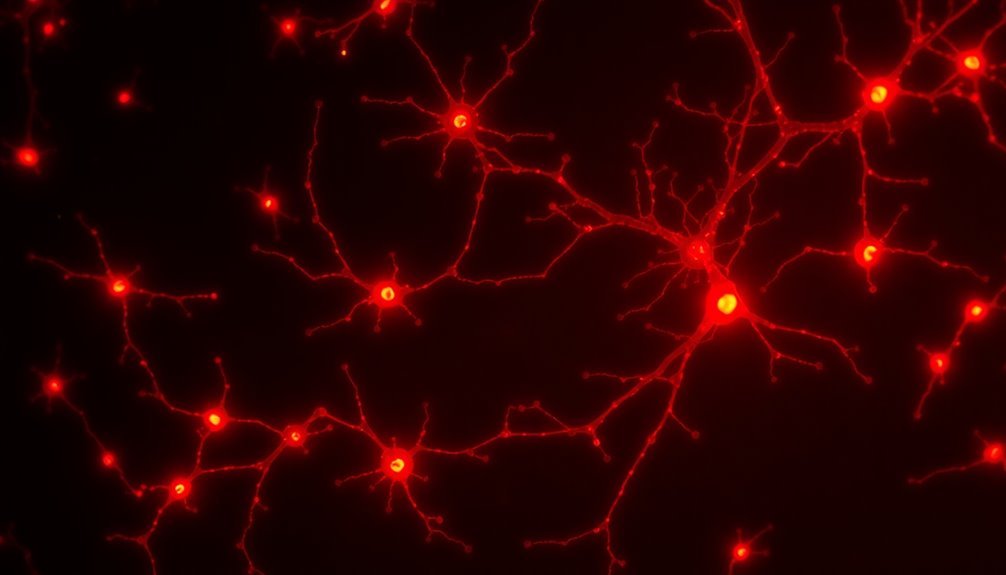
The complexity of cellular energy production becomes clearer when examining the specific mechanisms behind red light therapy's effects. When red and near-infrared light penetrate your skin, they target the mitochondria – your cells' energy-producing powerhouses.
These light waves specifically interact with cytochrome c oxidase, a significant enzyme in the electron transport chain. You'll find that red light therapy works by breaking the bond between nitric oxide and cytochrome c oxidase. This separation is essential because nitric oxide can inhibit the enzyme's function, limiting ATP production.
Once freed, cytochrome c oxidase can efficiently resume its role in energy generation, leading to increased ATP synthesis. The process doesn't stop there. Red light therapy also reduces the viscosity of the interfacial water layer within cells, making it easier for cellular components to function effectively.
This improvement occurs within the therapeutic window of 630-850 nm, where the light effectively stimulates ATP production without causing harm. As your cells receive this targeted light therapy, they're able to produce more ATP through enhanced oxidative phosphorylation, directly benefiting high-energy-demanding tissues like muscles, skin, and neurons.
Cellular Healing Through Light
Red and near-infrared light's remarkable healing effects extend far beyond basic ATP production. When these therapeutic wavelengths penetrate your cells, they trigger a cascade of healing responses that affect multiple aspects of cellular health. Your cells' mitochondria respond by ramping up their energy production while simultaneously reducing harmful oxidative stress.
You'll find this cellular healing process particularly effective in areas that demand high energy, such as your brain and muscles. The light therapy stimulates cytochrome c oxidase, which enhances your cells' ability to produce energy more efficiently. This increased energy production helps your cells repair damage, reduce inflammation, and function at their best.
Your body's healing response becomes even more pronounced as the therapy promotes mitochondrial biogenesis – creating new power plants within your cells. This process is especially beneficial if you're dealing with neurodegenerative conditions, muscle injuries, or skin damage.
The specific wavelengths of red and near-infrared light (typically 850-940nm) work at both the intact cell and mitochondrial levels, improving your cells' resistance to external stressors while accelerating natural healing processes.
Optimizing Light Therapy Results
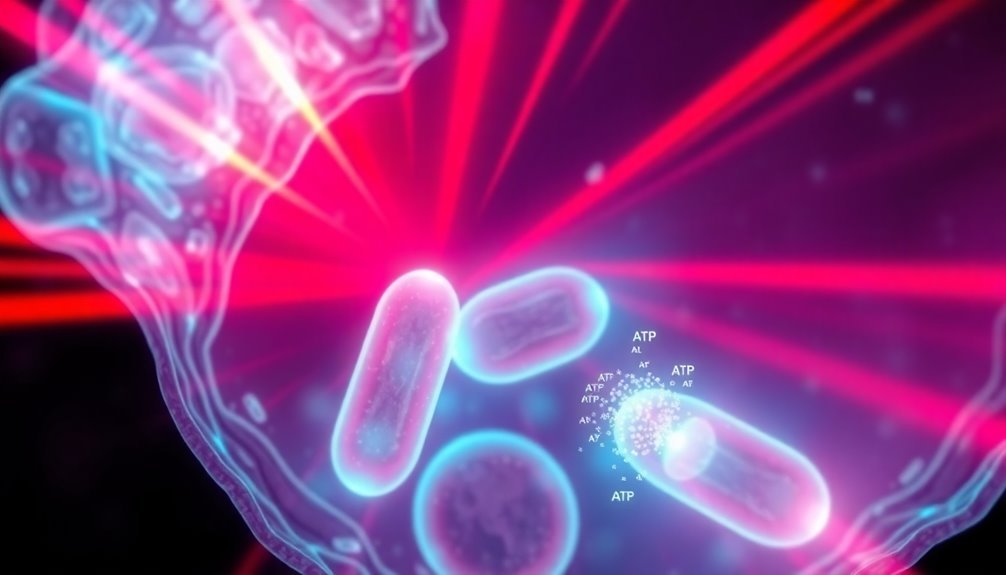
Maximizing the benefits of light therapy requires careful attention to several key parameters that directly influence ATP production in your cells. The power intensity you use is essential, with ideal ranges falling between 0.3 and 1.1 W. If you go too low, you'll inhibit ATP production, while the right intensity enhances your cellular energy output.
You'll want to focus on wavelengths between 630 nm and 1000 nm, as these penetrate effectively into your tissues. Wavelengths of 850 nm and 940 nm are particularly powerful for stimulating your electron transport system and boosting cytochrome c oxidase activity.
Your treatment duration matters greatly. While you might think longer sessions are better, short exposures of 30-60 seconds can effectively increase mitochondrial energy output.
You'll need to choose between pulsed and continuous light treatments based on your specific needs. Pulsed light helps your cells resist external stress, while continuous light effectively stimulates electron transport and enhances enzyme activity.
To avoid diminishing returns or potential adverse effects, you should maintain consistent power settings and carefully time your sessions. This precision guarantees you're maximizing ATP production rather than inducing oxidative stress.
Scientific Research and Evidence
Scientists continue to uncover compelling evidence supporting red light therapy's role in cellular energy production. Research published in Photomedicine and Laser Surgery demonstrates how red light therapy enhances mitochondrial function by improving cytochrome c oxidase activity, directly leading to increased ATP production.
You'll find particularly interesting studies showing how specific wavelengths affect cellular energy. At 850nm, continuous light irradiation considerably boosts both cell respiration and ATP production in neurons. This has profound implications for brain health and cellular energy management.
| Study Focus | Key Findings |
|---|---|
| Mitochondrial Function | Enhanced cytochrome c oxidase activity leads to improved ATP synthesis |
| Cellular Respiration | Notable increase in intact cell respiration with continuous light exposure |
| ATP Production | Direct correlation between light therapy and increased cellular energy levels |
| Oxidative Stress | Reduced reactive oxygen species and improved antioxidant defenses |
Research confirms that light intensity and power levels are vital factors in determining therapeutic outcomes. You'll get ideal results when the light therapy is properly calibrated, as studies show both too little and too much exposure can affect ATP production efficiency. This scientific evidence provides a solid foundation for understanding how red light therapy enhances cellular energy production.
Applications in Health Improvement
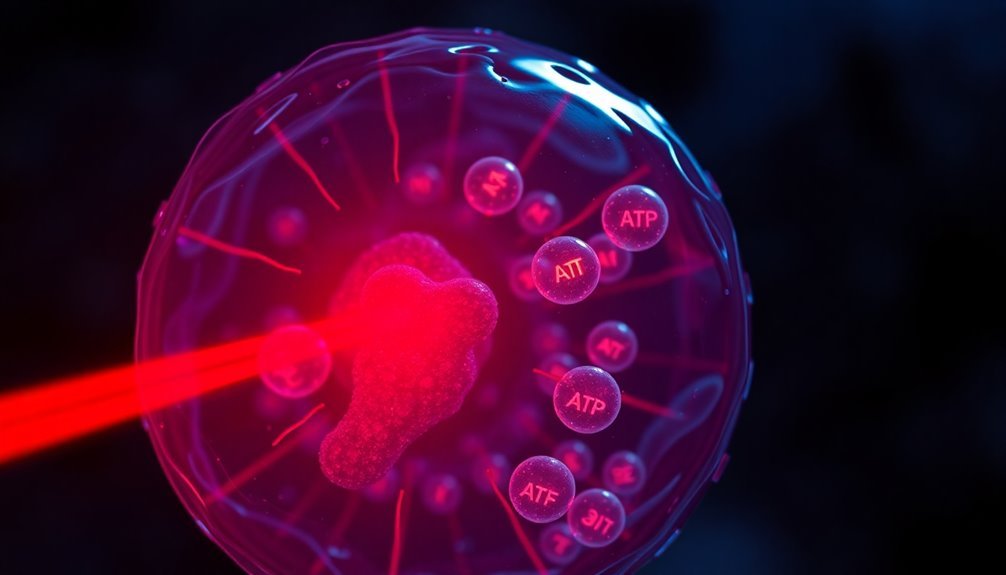
While ATP production occurs naturally in all living cells, understanding its targeted enhancement through light therapy opens up remarkable applications for health improvement.
You'll find that red light therapy's influence on ATP production directly impacts your muscle performance, helping you recover faster and maintain better endurance during physical activities.
When it comes to cellular repair, you're looking at enhanced healing processes throughout your body. Your cells can better withstand stress and damage thanks to improved ATP availability, while reduced oxidative stress keeps your mitochondria functioning efficiently.
You'll notice significant benefits for your brain health too. Red light therapy's ability to boost ATP production in neurons helps protect against neurodegenerative conditions and supports overall cognitive function.
Whether it's continuous or pulsed therapy, your brain cells receive the energy they need to maintain peak performance.
Your skin also reaps major benefits from increased ATP production. You'll see improvements in skin health as enhanced cellular respiration supports repair processes.
This means better resistance to environmental damage and reduced signs of aging, including fewer wrinkles and improved elasticity.
Frequently Asked Questions
Can Red Light Therapy Increase ATP Production During Sleep?
While red light therapy can boost ATP production through enhanced mitochondrial function, there's no direct evidence it works during sleep. You'll likely get better results using it before bedtime for energy benefits.
How Long Does Increased ATP Production Last After Red Light Exposure?
You'll see increased ATP production for 2 minutes after brief exposure, several hours with medium sessions, and longer-lasting benefits with regular treatments. The duration depends on your exposure time and light intensity.
Does Combining Red Light Therapy With Supplements Enhance ATP Production?
While you can combine supplements with red light therapy, there's limited evidence that this considerably boosts ATP production. Some supplements like CoQ10 and NAC may complement the therapy's effects, but more research is needed.
Can Too Much Red Light Exposure Decrease ATP Production?
Yes, you'll experience decreased ATP production if you overexpose yourself to red light therapy. Too much exposure can stress your cells, increase oxidative damage, and overwhelm your mitochondria, reducing their ability to generate ATP.
Do Certain Medications Interfere With Red Light's Atp-Boosting Effects?
Yes, certain medications can interfere with red light's ATP-boosting benefits. You'll want to be careful with nitric oxide donors, antioxidant supplements, and mitochondrial inhibitors, as they may reduce the therapy's effectiveness on ATP production.
In Summary
You've discovered how red light wavelengths can boost your body's natural energy production through ATP. By targeting your cells' mitochondria and activating cytochrome c oxidase, you're able to enhance cellular function and healing. When you apply red light therapy consistently, you'll see improved energy levels and faster recovery. The science is clear: red light therapy offers a natural, effective way to optimize your cellular health.

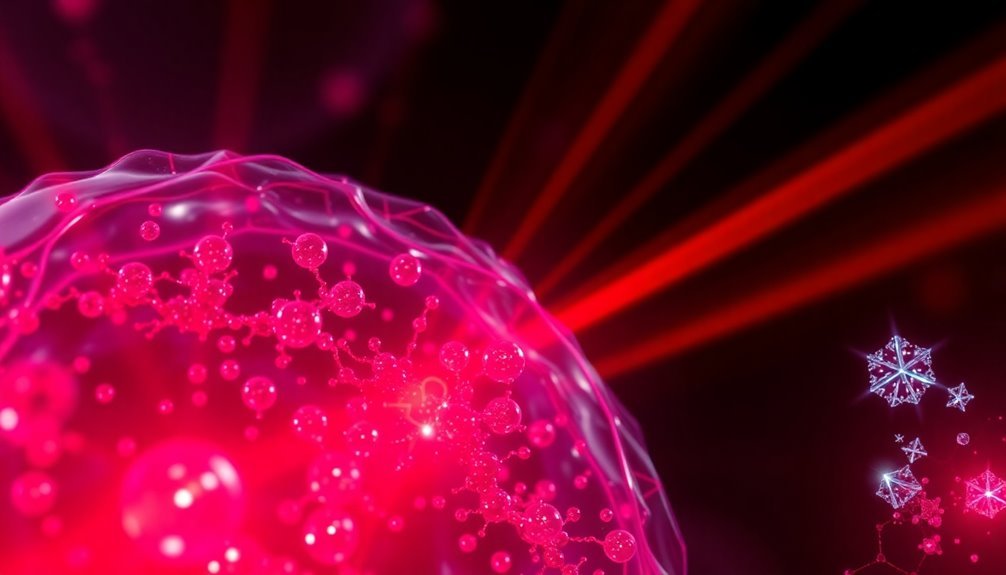



Leave a Reply